SmartRock-Based Research on Gyratory Locking Point for Stone Mastic Asphalt Mixture
Abstract
:1. Introduction
2. Methods
2.1. Materials
2.2. Experimental Equipment
2.2.1. SmartRock
2.2.2. Gyratory Compactor
2.3. Methods
2.3.1. Data Collection Process
2.3.2. Coordinate System Conversion
2.3.3. Experiment Schedule
2.3.4. Gyratory Locking Point Determination
3. Results and Discussion
3.1. Representative Stress Value When SmartRocks Were Embedded in Various Positions
3.2. Representative Stress Value with Different Compaction Temperatures
3.3. Gyratory Locking Point Comparison between the Traditional Method and New Method
3.4. Representative Rotation Angle Value
3.5. Representative Acceleration Value
3.6. Limitations and Recommendations
4. Summary and Conclusions
- (1)
- The representative value of the triaxial stress reached the final stable state simultaneously, and the aggregates’ interlocking sequence was the upper part first, then the lower part, and lastly the middle part. The specimen’s locking point determined by the result of the center-positioned SmartRock is more reasonable.
- (2)
- The higher the compaction temperature, the earlier the locking point was reached. In addition, the locking points determined by the representative triaxial stress value were closer to the traditional evaluation results (LP3 or LP2-2-3).
- (3)
- SmartRocks embedded in the specimen’s upper and lower parts had a more significant impact on the results of the traditional locking point (LP3 or LP2-2-3). When the SmartRock was located in the middle, there was a more negligible effect on the asphalt mixture’s interlocking results during gyratory compaction.
- (4)
- The representative rotation angle value reached a plateau earlier than the representative stress value, which means that the mechanical index interlocking lags behind the volume index interlocking.
- (5)
- Overall, the representative acceleration value is unsuitable for characterizing the interlocking process during gyratory compaction. Due to the gyratory compactor working at a constant speed and a specific angle, the representative horizontal direction (X-axis or Y-axis) acceleration value changes with no significant regularity. In addition, there is an original data packet loss problem during acceleration data collection, leading to incomplete acceleration peak data. A feasible way to solve this problem might be to enhance the Bluetooth transmission signal.
Author Contributions
Funding
Institutional Review Board Statement
Informed Consent Statement
Data Availability Statement
Conflicts of Interest
References
- Brown, E.R. Density of Asphalt Concrete-How Much is Needed? In Proceedings of the Transportation Research Board, Washington, DC, USA, 1 January 1990.
- Huber, G.A.; Heiman, G.H. Effect of asphalt concrete parameters on rutting performance: A field investigation. In Proceedings of the Association of Asphalt Paving Technologists, Ottawa, ON, Canada, 31 January 1986. [Google Scholar]
- Mcgennis, R.B.; Anderson, R.M.; Kennedy, T.W.; Solaimanian, M. Background of Superpave Asphalt Mixture Design and Analysis. National Asphalt Training Center Demonstration Project 101; The Asphalt Institue: Lexington, KY, USA, 1995. [Google Scholar]
- Bahia, H.U.; Friemel, T.P.; Peterson, P.A. Optimization of constructibility and resistance to traffic: A new design approach for HMA using the superpave compactor. J. Assoc. Asph. Paving Technol. 1998, 67, 189–232. [Google Scholar]
- Mallick, R.B. Use of Superpave Gyratory Compactor To Characterize Hot-Mix Asphalt. Transp. Res. Rec. 1999, 1681, 86–96. [Google Scholar] [CrossRef]
- Masad, E.; Kassem, E.; Chowdhury, A.; You, Z. A Method for Predicting Asphalt Mixture Compactability and Its Influence On Mechanical Properties; Texas Transportation Institute, The Texas A&M University System: College Station, TX, USA, 2009. [Google Scholar]
- Vavrik, W.R.; Carpenter, S.H. Calculating Air Voids at Specified Number of Gyrations in Superpave Gyratory Compactor. Transp. Res. Rec. 1998, 1630, 117–125. [Google Scholar] [CrossRef]
- Vavrick, W.R.; Huber, G.; Pine, W.J.; Bailey, R. Bailey Method Summarized for Gradation Selection in Hot-Mix Asphalt Design. In Proceedings of the Transportation Research Board, Washington, DC, USA, 8 October 2002. [Google Scholar]
- Polaczyk, P.; Han, B.; Huang, B.; Jia, X.; Shu, X. Evaluation of the hot mix asphalt compactability utilizing the impact compaction method. Constr. Build. Mater. 2018, 187, 131–137. [Google Scholar] [CrossRef]
- Polaczyk, P.; Huang, B.; Shu, X.; Gong, H. Investigation into Locking Point of Asphalt Mixtures Utilizing Superpave and Marshall Compactors. J. Mater. Civ. Eng. 2019, 31, 04019188. [Google Scholar] [CrossRef]
- Polaczyk, P.; Shu, X.; Gong, H.; Huang, B. Influence of aggregates angularity on the locking point of asphalt mixtures. Road Mater. Pavement Des. 2019, 20, S183–S195. [Google Scholar] [CrossRef]
- Polaczyk, P.; Han, B.; Gong, H.; Ma, Y.; Huang, B. Influence of Aggregate Gradation on the Compactability of Asphalt Mixtures Utilizing Locking Point. J. Mater. Civ. Eng. 2021, 33, 04021005. [Google Scholar] [CrossRef]
- Cheng, Z.; Jia, X.; Jiang, H.; Hu, W.; Huang, B. Quantification of impact compaction locking point for asphalt mixture. Constr. Build. Mater. 2021, 302, 124410. [Google Scholar] [CrossRef]
- Zhiqiang, C.; Andrzej, P.P.; De, Z.; Wei, H.; Baoshan, H. A method for determining impact locking point of asphalt mixtures based on dynamic response. J. Cent. South Univ. 2021, 52, 2232–2245. [Google Scholar]
- Alabama Department of Transportation. Special Provision No. 02-0360(5)-2004—Amendment for Section 424; Alabama Standard Specifications: Montgomery, AL, USA, 2004. [Google Scholar]
- Georgia Department of Transportation. Special Provision-Section 828—Hot-Mix Asphaltic Concrete Mixtures; Georgia Standard Specifications: Atlanta, GA, USA, 2003. [Google Scholar]
- Anderson, R.M.; Turner, P.A.; Peterson, R.L. Relationship of Superpave Gyratory Compaction Properties to HMA Rutting Behavior; Transportation Research Board Executive Committee: Washington, DC, USA, 2002. [Google Scholar]
- Liu, S.; Qiu, T.; Qian, Y.; Huang, H.; Tutumluer, E.; Shen, S. Simulations of large-scale triaxial shear tests on ballast aggregates using sensing mechanism and real-time (SMART) computing. Comput. Geotech. 2019, 110, 184–198. [Google Scholar] [CrossRef]
- Liu, S.; Huang, H.; Qiu, T.; Gao, L. Comparison of Laboratory Testing Using SmartRock and Discrete Element Modeling of Ballast Particle Movement. J. Mater. Civ. Eng. 2017, 29, D6016001. [Google Scholar] [CrossRef]
- Wang, X.; Shen, S.; Huang, H.; Almeida, L.C. Characterization of particle movement in Superpave gyratory compactor at meso-scale using SmartRock sensors. Constr. Build. Mater. 2018, 175, 206–214. [Google Scholar] [CrossRef]
- Wang, X.; Shen, S.; Huang, H.; Zhang, Z. Towards smart compaction: Particle movement characteristics from laboratory to the field. Constr. Build. Mater. 2019, 218, 323–332. [Google Scholar] [CrossRef]
- Dan, H.-C.; Yang, D.; Liu, X.; Peng, A.-P.; Zhang, Z. Experimental investigation on dynamic response of asphalt pavement using SmartRock sensor under vibrating compaction loading. Constr. Build. Mater. 2020, 247, 118592. [Google Scholar] [CrossRef]
- Shi, B.; Shen, S.; Liu, L.; Wang, X. Estimation of Vehicle Speed from Pavement Stress Responses Using Wireless Sensors. J. Transp. Eng. Part B Pavements 2021, 147, 04021028. [Google Scholar] [CrossRef]
- Wang, X.; Shen, S.; Huang, H. Meso-Scale Kinematic Responses of Asphalt Mixture in Both Field and Laboratory Compaction. Transp. Res. Rec. J. Transp. Res. Board 2021, 2675, 03611981211009222. [Google Scholar] [CrossRef]
- Zhang, C.; Shen, S.; Huang, H.; Wang, L. Estimation of the Vehicle Speed Using Cross-Correlation Algorithms and MEMS Wireless Sensors. Sensors 2021, 21, 1721. [Google Scholar] [CrossRef]
- Dan, H.-C.; Yang, D.; Zhao, L.-H.; Wang, S.-P.; Zhang, Z. Meso-scale study on compaction characteristics of asphalt mixtures in Superpave gyratory compaction using SmartRock sensors. Constr. Build. Mater. 2020, 262, 120874. [Google Scholar] [CrossRef]
- Ministry of Transport of the People’s Republic of China. Technical Specifications for Construction of Highway Asphalt Pavements; The People’s Communication Publishing Company: Beijing, China, 2004; Volume JTG F40-2004. [Google Scholar]
- Jiang, X.; Zhang, M.; Xiao, R.; Polaczyk, P.; Bai, Y.; Huang, B. An investigation of structural responses of inverted pavements by numerical approaches considering nonlinear stress-dependent properties of unbound aggregate layer. Constr. Build. Mater. 2021, 303, 124505. [Google Scholar] [CrossRef]
- Zhang, D.; Cheng, Z.Q.; Geng, D.J.; Xie, S.J.; Wang, T. Experimental and numerical analysis on mesoscale mechanical behavior of coarse aggregates in the asphalt mixture during gyratory compaction. Processes 2021, 10, 47. [Google Scholar] [CrossRef]
- Jiang, X.; Gabrielson, J.; Huang, B.; Bai, Y.; Polaczyk, P.; Zhang, M.; Hu, W.; Xiao, R. Evaluation of inverted pavement by structural condition indicators from falling weight deflecometer. Constr. Build. Mater. 2021, 319, 125991. [Google Scholar] [CrossRef]
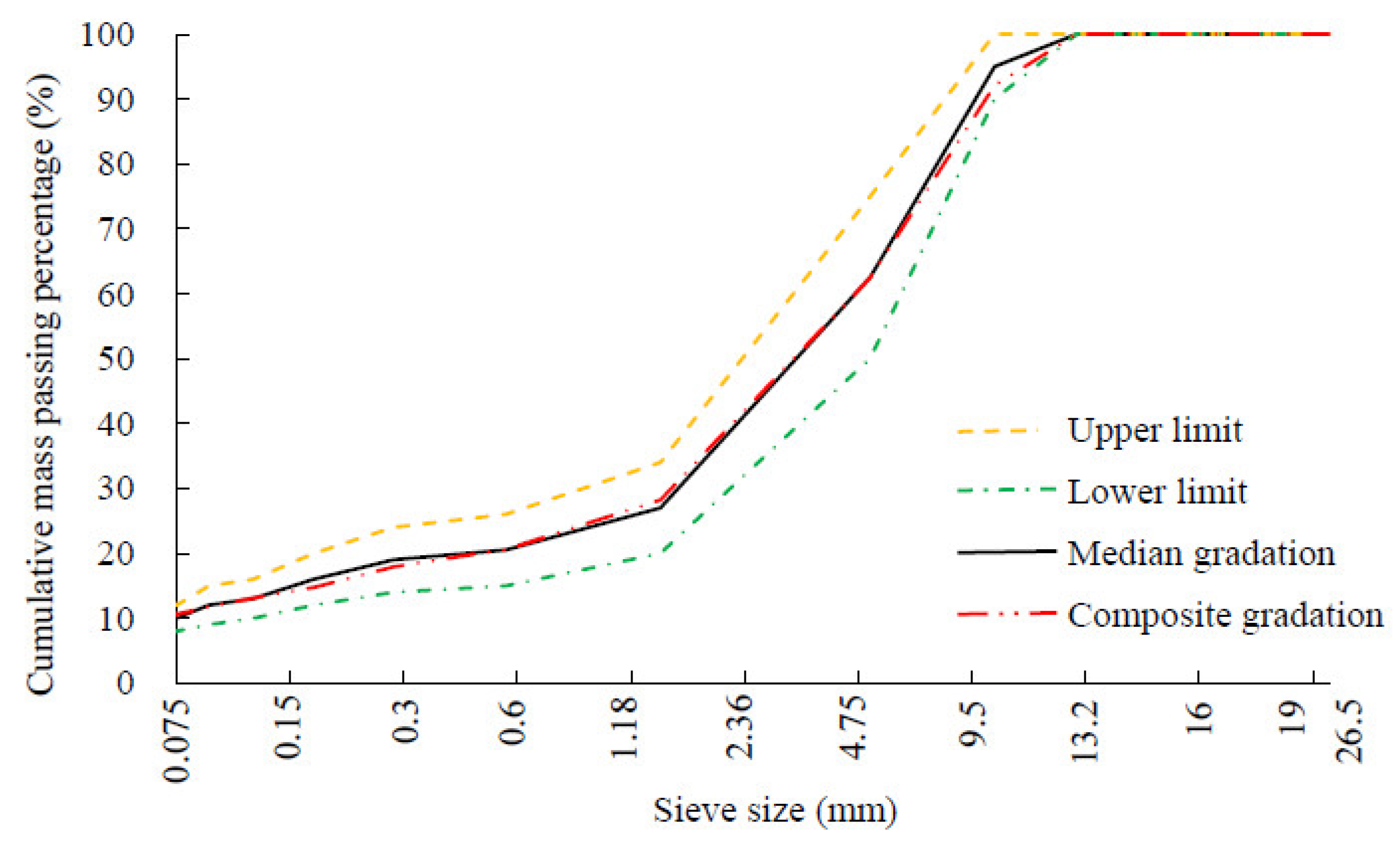
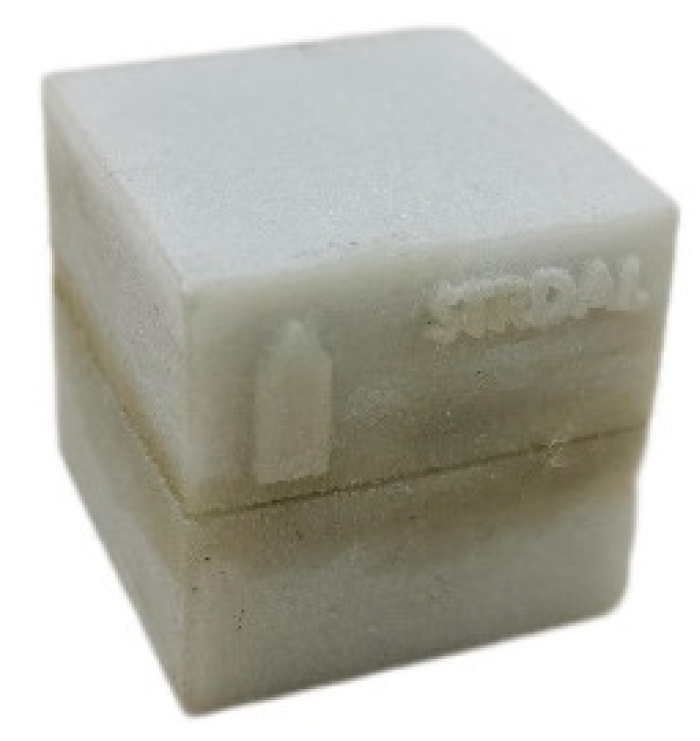
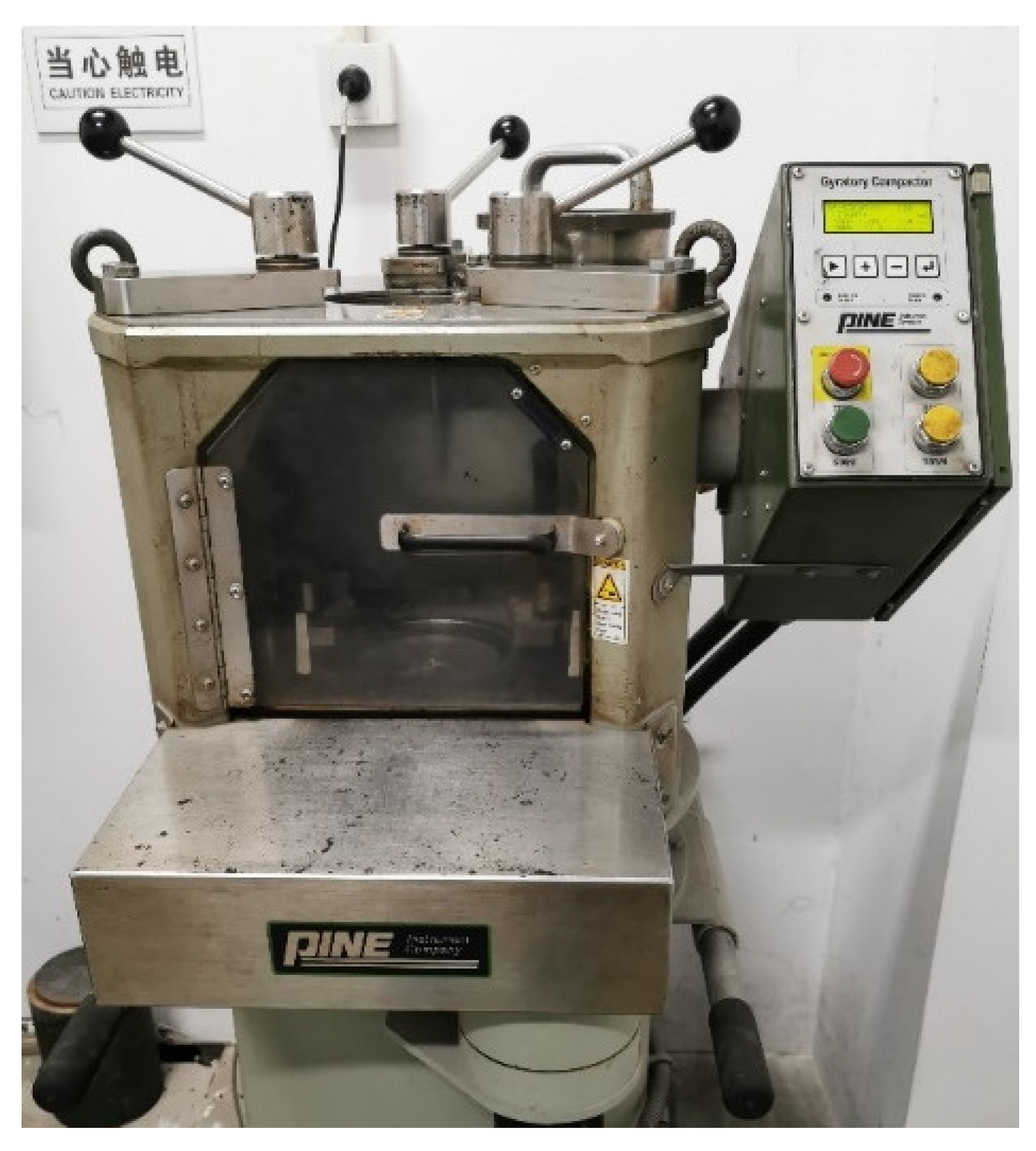


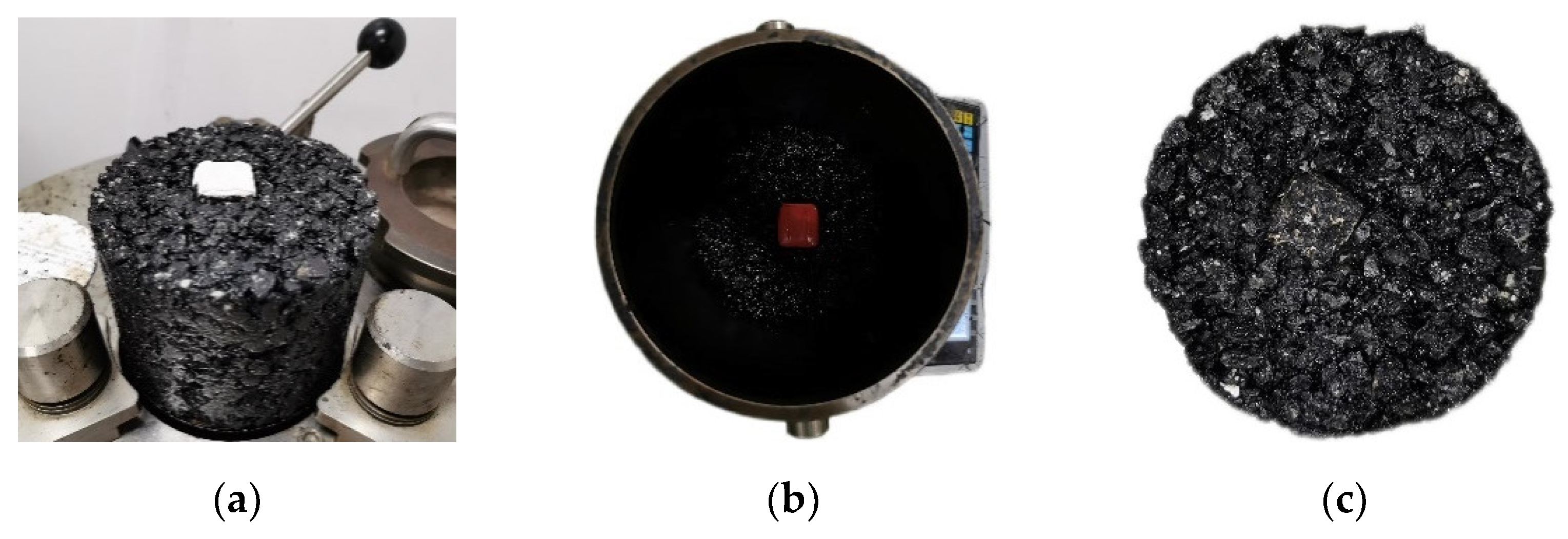

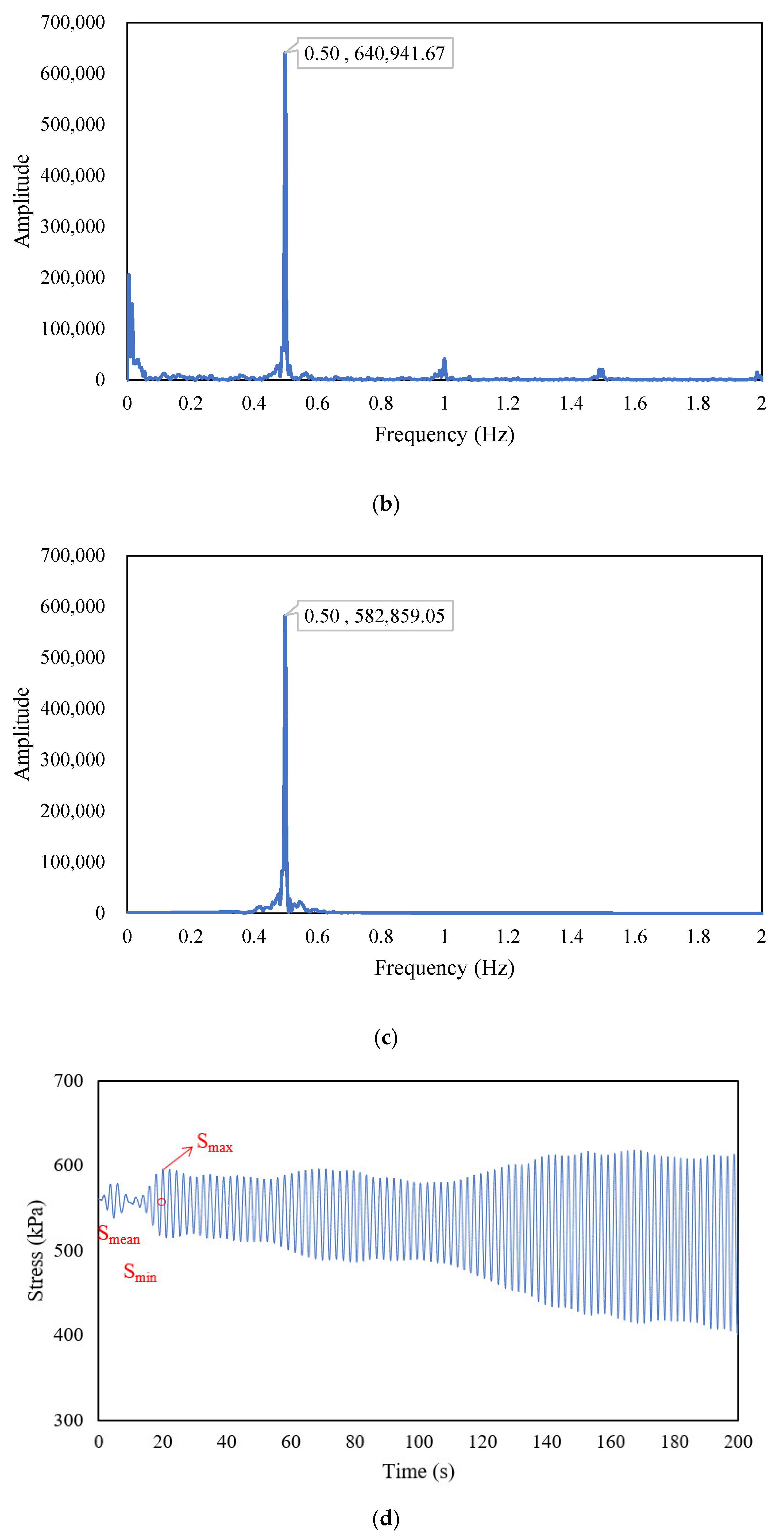

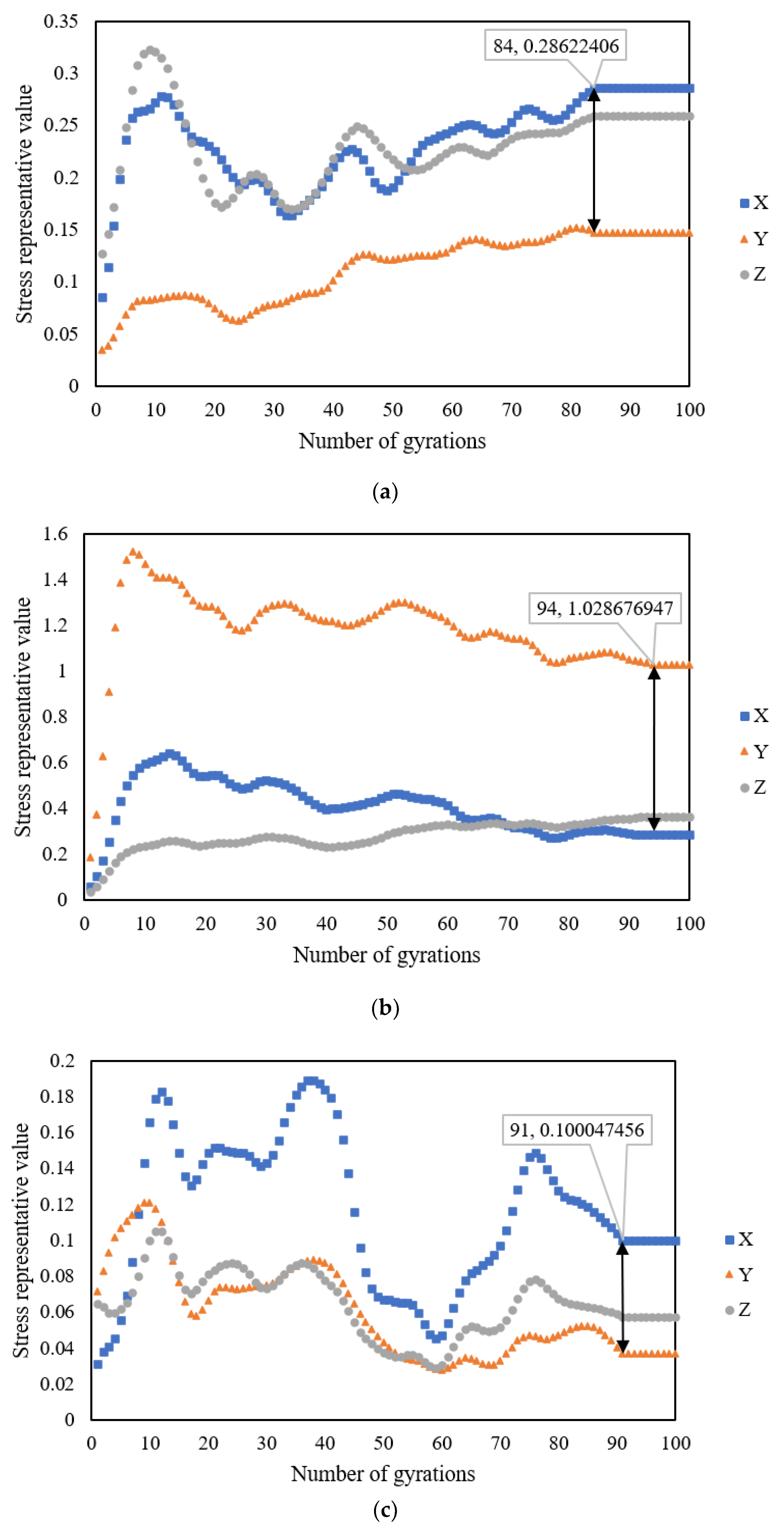
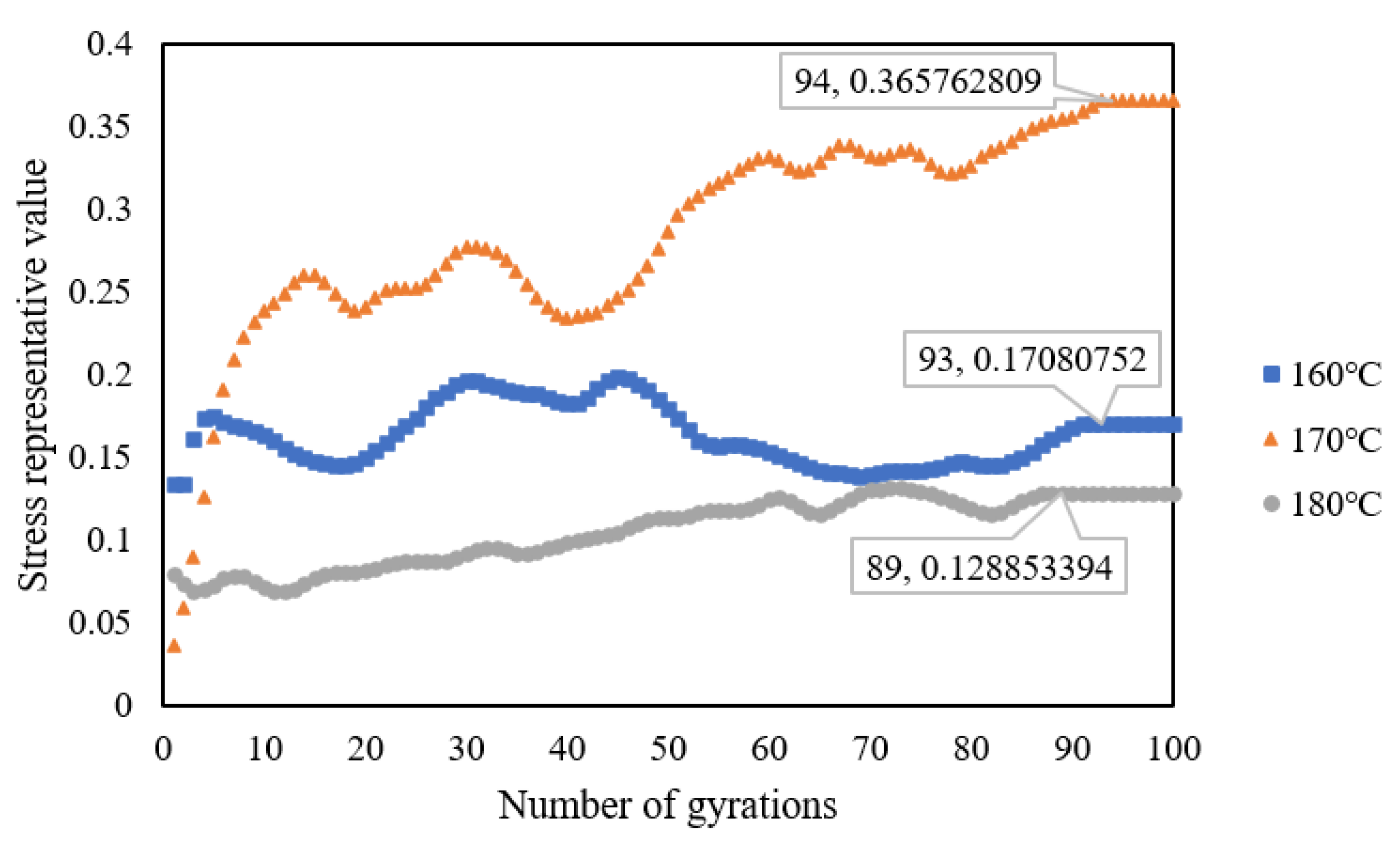

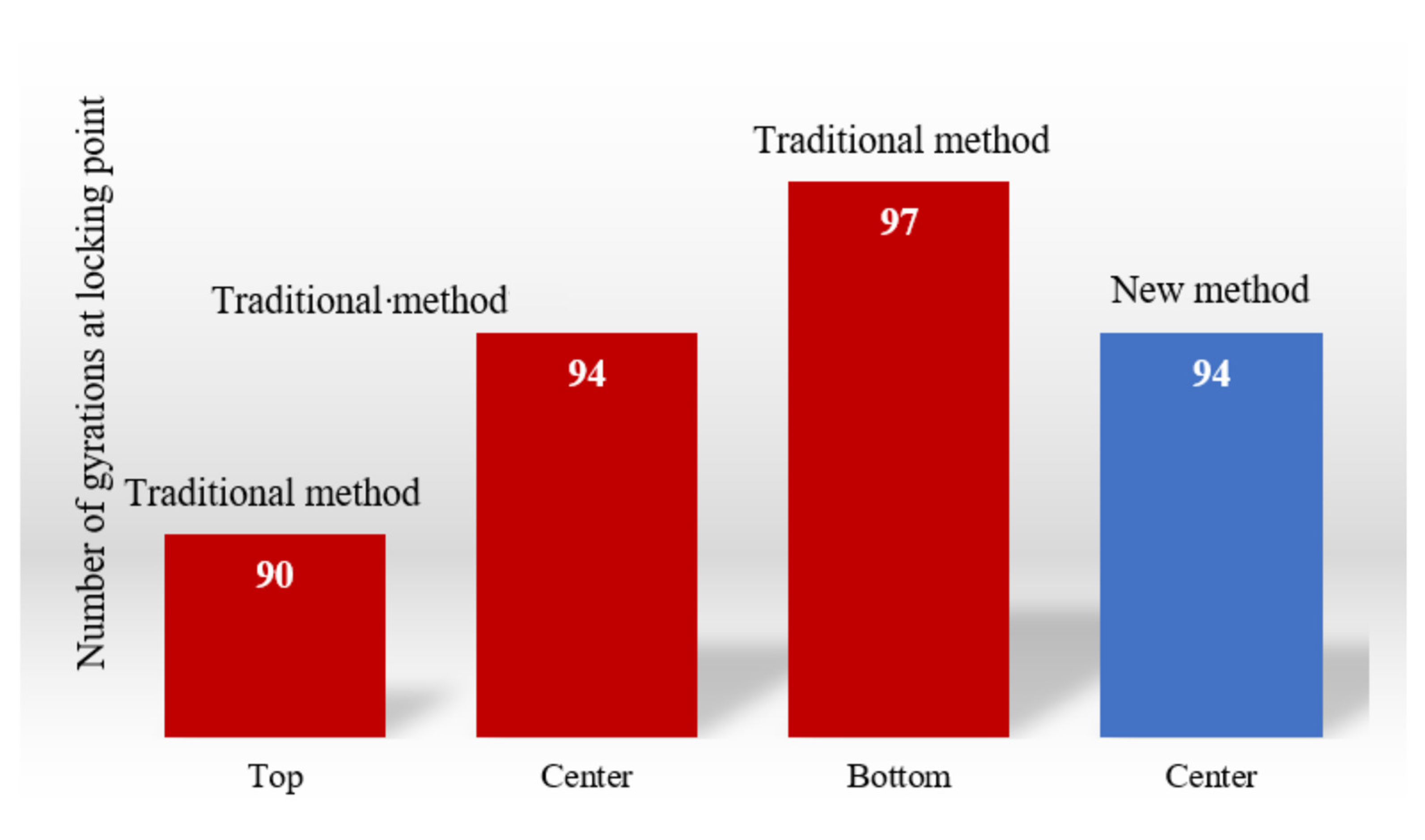



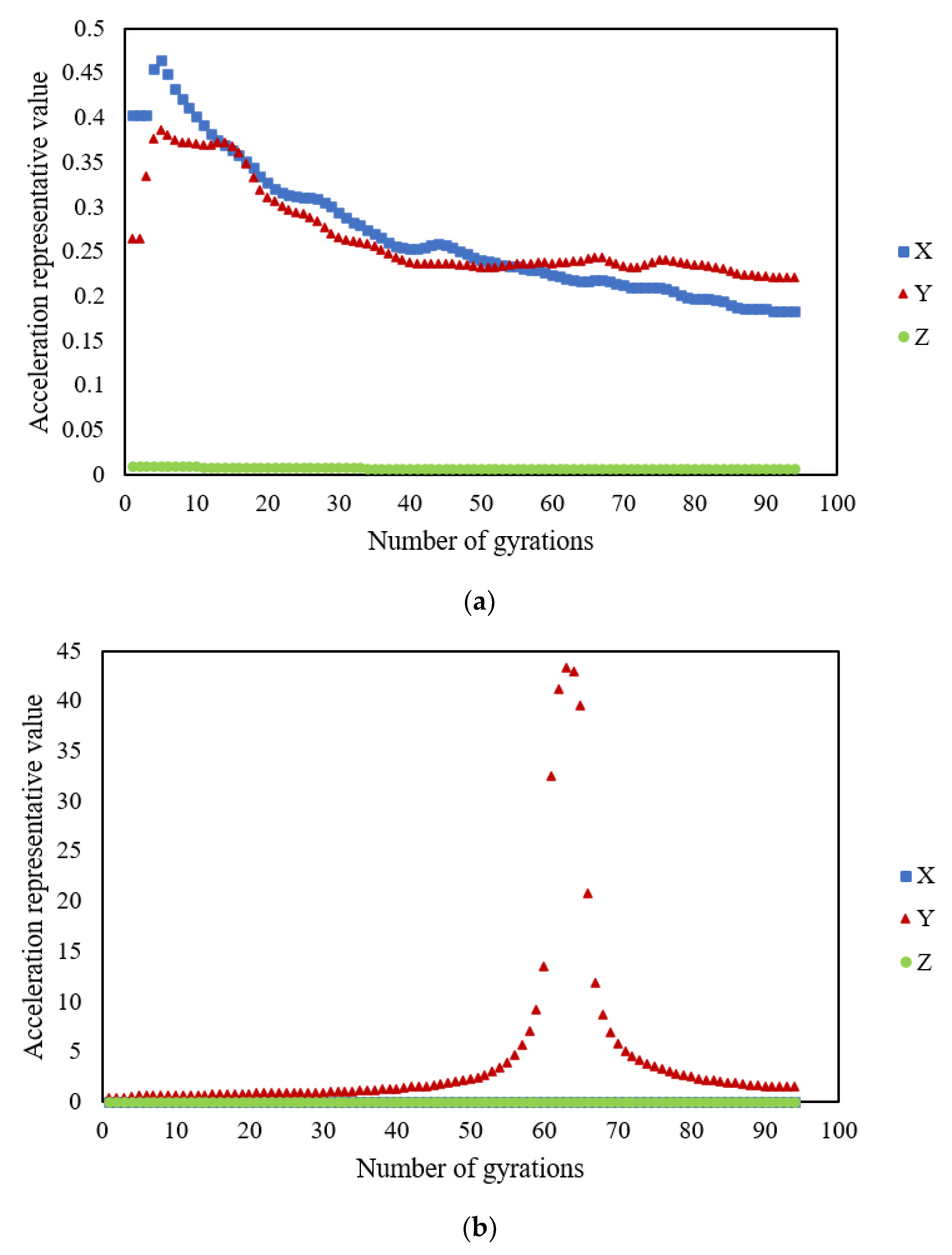
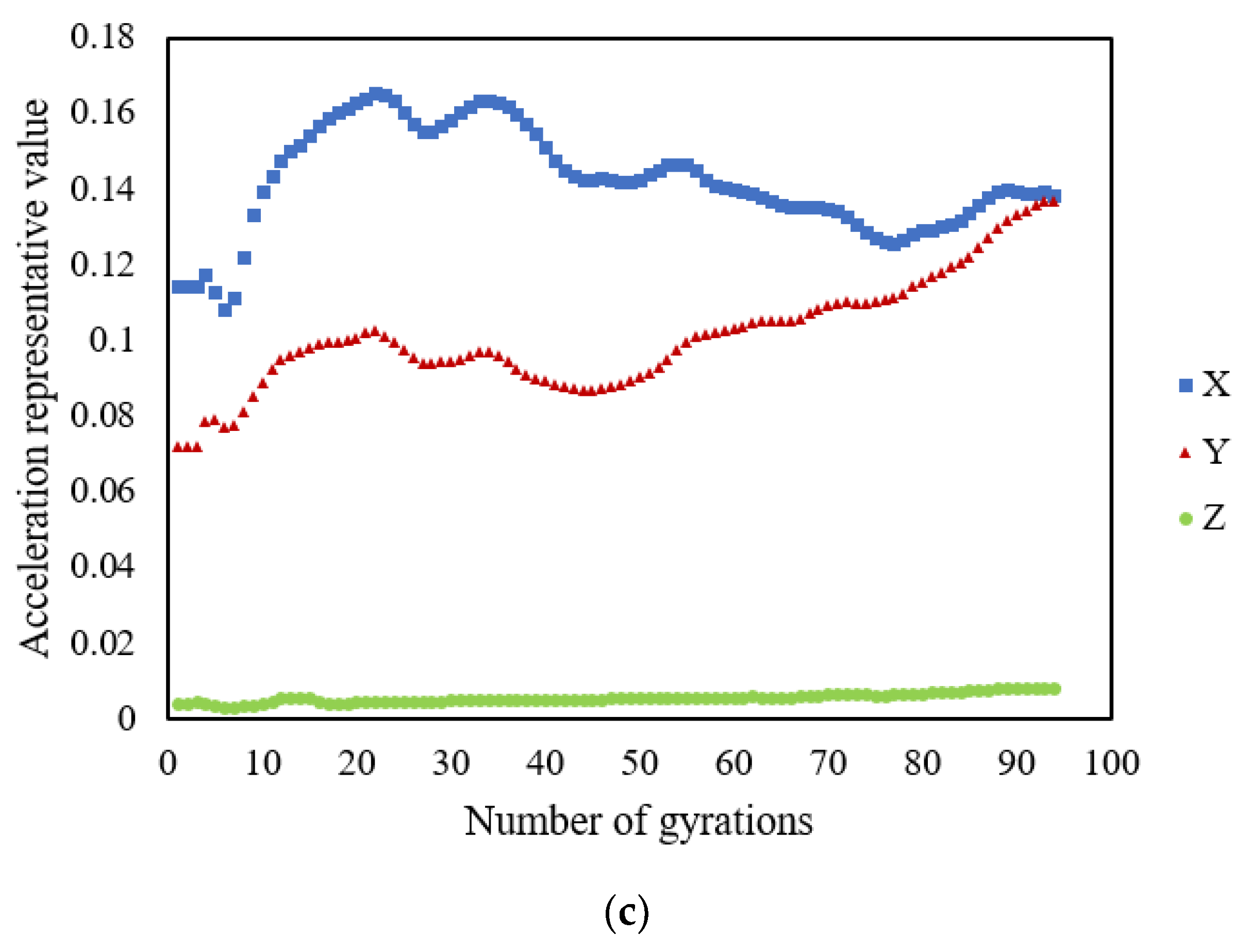
| Test Items | Measured Value | Requirement Value |
|---|---|---|
| Penetration (25 °C, 100 g, 5 s) (0.01 cm) | 48 | 30–50 |
| Ductility (5 cm/min, 5 °C) (cm) | 30 | ≥20 |
| Softening point at 5 °C | 81.5 | ≥70 |
| Density (25 °C) (g/cm3) | 1.031 | Measured value |
| Test Items | Measured Value | Requirement Value |
|---|---|---|
| Crushing value (%) | 13.5 | ≤22% |
| Flat, elongated particle content (%) | 8.5 | ≤12% |
| Particle size < 0.075 mm, content (%) | 0.5 | ≤1.0% |
| Adhesion | 5 | ≥5 |
| Test Items | Measured Value | Requirement Value |
|---|---|---|
| Apparent density (g/cm3) | 2.705 | ≥2.50 |
| Water content (%) | 0.4 | ≤1 |
| Particle size < 0.6 mm, content (%) | 100 | 100 |
| Particle size < 0.15 mm, content (%) | 93.2 | 90~100 |
| Particle size < 0.075 mm, content (%) | 87.5 | 75~100 |
| Exterior | No clumps | No clumps |
| Hydrophilic coefficient | 0.81 | <1.0 |
| Aggregate Grading (%) | Filler (%) | Asphalt Content (%) | Lignin Fiber (%) | Flame Retardant (%) | |||
|---|---|---|---|---|---|---|---|
| 0–3 | 3–5 | 5–10 | 10–15 | ||||
| 14 | 5 | 34 | 37 | 10 | 5.7 | 0.35 | 0.3 |
| NO. | ID | Type | Direction | a | b | c | U0 |
|---|---|---|---|---|---|---|---|
| 1 | 18:04:ED:6D:31:6E | High temperature resistant | front | −0.048 | 0.094 | −0.718 | 2.28 |
| left | −0.054 | 0.127 | −1.137 | 2.30 | |||
| bottom | −0.061 | 0.067 | −0.692 | 2.38 | |||
| 2 | 60:77:71:C6:71:45 | High temperature resistant | front | −0.044 | −0.065 | 0.042 | 2.32 |
| left | −0.050 | −0.065 | −0.084 | 1.86 | |||
| bottom | −0.053 | −0.022 | −0.396 | 2.04 | |||
| 3 | 60:77:71:C6:70:C4 | High temperature resistant | front | −0.053 | 0.092 | −0.661 | 2.30 |
| left | −0.067 | −0.021 | −0.416 | 2.44 | |||
| bottom | −0.052 | 0.003 | −0.424 | 2.00 |
| Asphalt Mixture | Sample Weight (kg) | SmartRock’s Embedded Position | Compaction Temperature (°C) | Sampling Frequency (ms) | Number of Gyrations | ||||
|---|---|---|---|---|---|---|---|---|---|
| 160 | 170 | 180 | Stress | Acceleration | Rotation Angle | ||||
| SMA 13 | 4.8 | top | × | √ | × | 10 | 10 | 60 | 100 |
| center | √ | √ | √ | ||||||
| bottom | × | √ | × | ||||||
Publisher’s Note: MDPI stays neutral with regard to jurisdictional claims in published maps and institutional affiliations. |
© 2022 by the authors. Licensee MDPI, Basel, Switzerland. This article is an open access article distributed under the terms and conditions of the Creative Commons Attribution (CC BY) license (https://creativecommons.org/licenses/by/4.0/).
Share and Cite
Cheng, Z.; Zhang, D.; Xie, S.; Polaczyk, P.A.; Wang, T. SmartRock-Based Research on Gyratory Locking Point for Stone Mastic Asphalt Mixture. Buildings 2022, 12, 97. https://doi.org/10.3390/buildings12020097
Cheng Z, Zhang D, Xie S, Polaczyk PA, Wang T. SmartRock-Based Research on Gyratory Locking Point for Stone Mastic Asphalt Mixture. Buildings. 2022; 12(2):97. https://doi.org/10.3390/buildings12020097
Chicago/Turabian StyleCheng, Zhiqiang, De Zhang, Shengjia Xie, Pawel Andrzej Polaczyk, and Tao Wang. 2022. "SmartRock-Based Research on Gyratory Locking Point for Stone Mastic Asphalt Mixture" Buildings 12, no. 2: 97. https://doi.org/10.3390/buildings12020097






